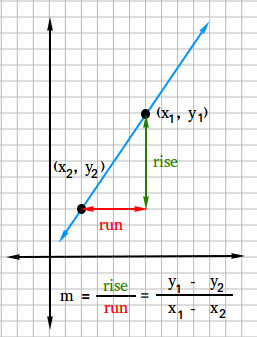What is the Slope of a Line? Definition and Examples
What is the slope of a line? The slope of a line is the ratio of the rise to the run between any two points (x1, y1) and (x2, y2).
The rise is the distance straight up (or vertical distance) between the two points and the run is the horizontal distance between the two points.

The rise can also be called vertical change and the run can also be called horizontal change.
Different ways to define the slope of a line
Slope = vertical change / horizontal change
Slope = vertical distance / horizontal distance
Slope = rise / run
Slope = (y1 - y2) / (x1 - x2)
Example showing how to find the slope of a line
Use the two points shown in black in the figure above to find the slope of the line.
Slope = rise / run = 6 / 4 = 3 / 2
Slope = (y1 - y2) / (x1 - x2)
(x1, y1) = (6, 9) and (x2, y2) = (2, 3)
Slope = (y1 - y2) / (x1 - x2)
Slope = (9 - 3) / (6 - 2)
Slope = (6) / (4) = 3 / 2